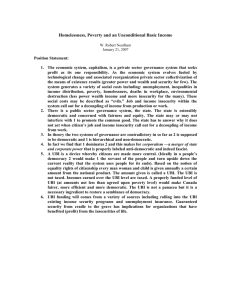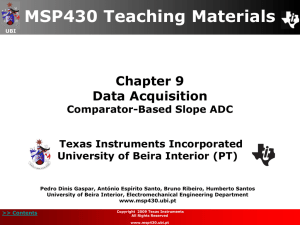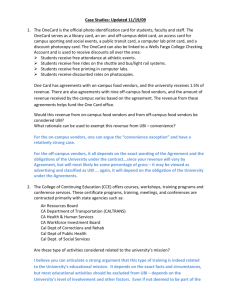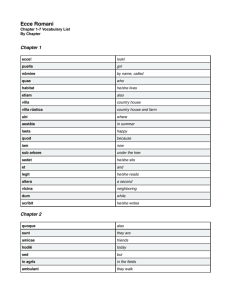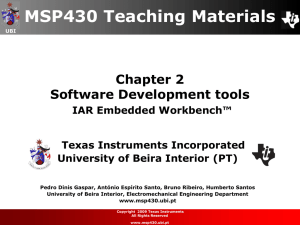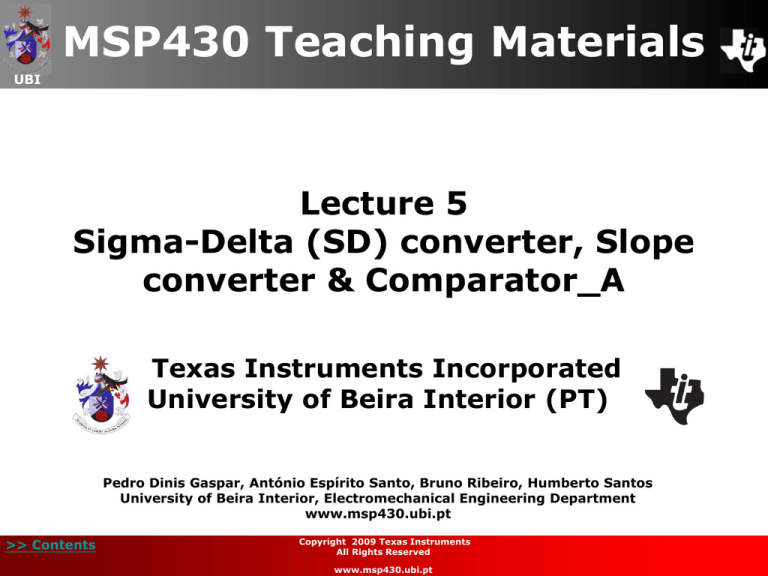
MSP430 Teaching Materials
UBI
Lecture 5
Sigma-Delta (SD) converter, Slope
converter & Comparator_A
Texas Instruments Incorporated
University of Beira Interior (PT)
Pedro Dinis Gaspar, António Espírito Santo, Bruno Ribeiro, Humberto Santos
University of Beira Interior, Electromechanical Engineering Department
www.msp430.ubi.pt
>> Contents
Copyright 2009 Texas Instruments
All Rights Reserved
www.msp430.ubi.pt
Contents (1/2)
UBI
Sigma-Delta (SD) converter
Introduction to Sigma-Delta ADC :
• Delta modulator
• Digital filter
• Decimation digital filter
MSP430 SD16(A) – Sigma-Delta ADC
Slope converter
Comparator-Based Slope ADC:
• Single- and dual- slope ADC
• Resistive sensors measurements
• Voltage measurements
>> Contents
Copyright 2009 Texas Instruments
All Rights Reserved
www.msp430.ubi.pt
2
Contents (2/2)
UBI
Comparator_A
Introduction to Comparator_A
Features
Voltage reference generator
Comparator_A interrupts
Comparator_A registers
>> Contents
Copyright 2009 Texas Instruments
All Rights Reserved
www.msp430.ubi.pt
3
Sigma-Delta ADC Introduction (1/8)
UBI
Sigma-Delta (SD) converter determines the digital word:
• By oversampling the input signal using sigma-delta
modulation;
• Applying digital filtering;
• Reducing data rate by collecting modulator output bits
(decimation).
>> Contents
Copyright 2009 Texas Instruments
All Rights Reserved
www.msp430.ubi.pt
4
Sigma-Delta ADC Introduction (2/8)
UBI
Delta modulator:
Quantizes the difference between the current analogue input
signal and the average of the previous samples.
Example: 1st order modulator (simplest form):
• Quantization (comparator): Output={1,0} if Input={+,-}
• Demodulator (integrator - 1 bit DAC): Output={,} if
Input={1,0}.
>> Contents
Copyright 2009 Texas Instruments
All Rights Reserved
www.msp430.ubi.pt
5
Sigma-Delta ADC Introduction (3/8)
UBI
Delta modulator:
Density of “1’s" at the modulator OUT is proportional to IN
signal:
• Increasing IN, the comparator generates a greater number
of “1’s";
• Decreasing IN, the comparator generates a lesser number
of “1’s".
By summing the error voltage, the integrator acts as a:
• Lowpass filter for the input signal;
• Highpass filter for the quantization noise.
>> Contents
Copyright 2009 Texas Instruments
All Rights Reserved
www.msp430.ubi.pt
6
Sigma-Delta ADC Introduction (4/8)
UBI
Delta modulator:
Most quantization noise is pushed into higher frequencies;
Oversampling changes noise distribution (but not total noise);
Quantization noise limits the dynamic range of the ADC;
Noise is the “round-off” error of analogue signal quantization.
>> Contents
Copyright 2009 Texas Instruments
All Rights Reserved
www.msp430.ubi.pt
7
Sigma-Delta ADC Introduction (5/8)
UBI
Digital Filter:
Averages the 1-bit data stream;
Improves the analogue to digital conversion resolution;
Removes quantization noise outside the band of interest;
Determines signal bandwidth, settling time and stopband
rejection.
>> Contents
Copyright 2009 Texas Instruments
All Rights Reserved
www.msp430.ubi.pt
8
Sigma-Delta ADC Introduction (6/8)
UBI
Digital Filter:
SD converters: widely used lowpass filter: Sinc³ or Sinc5 types.
>> Contents
Copyright 2009 Texas Instruments
All Rights Reserved
www.msp430.ubi.pt
9
Sigma-Delta ADC Introduction (7/8)
UBI
Digital Filter:
The output of the digital filter will be a data stream:
>> Contents
Copyright 2009 Texas Instruments
All Rights Reserved
www.msp430.ubi.pt
10
Sigma-Delta ADC Introduction (8/8)
UBI
Decimation Digital Filter:
Decimation: Reduces the sampling rate down from the
oversampling rate without losing information (eliminates
redundant data);
Using the Nyquist theorem (fsample > 2finput) and the
oversampling at the delta modulator, the input signal can be
reliably reconstructed without distortion.
>> Contents
Copyright 2009 Texas Instruments
All Rights Reserved
www.msp430.ubi.pt
11
SD16(A) (1/2)
Introduction
UBI
Applications MSP430 devices with up to 7 SD ADCs:
Portable medical (F42xx and FG42xx);
Energy metering (FE42x(A), F47xx, F471xx);
Generic applications (F42x and F20x3).
SD16_A: eZ430-F2013 hardware development tool;
SD16_A supports:
16-bit SD core;
Reference generator;
External analogue inputs;
Internal VCC sense;
Integrated temperature sensor.
>> Contents
Copyright 2009 Texas Instruments
All Rights Reserved
www.msp430.ubi.pt
12
SD16(A) (2/2)
Introduction
UBI
SD16_A block diagram:
>> Contents
Copyright 2009 Texas Instruments
All Rights Reserved
www.msp430.ubi.pt
13
SD16(A)
SD16_A Features
UBI
16-bit sigma-delta architecture;
Up to eight multiplexed differential analogue inputs per
channel;
Software selectable on-chip reference voltage generation
(1.2 V);
Software selectable internal or external reference;
Built-in temperature sensor;
Up to 1.1 MHz modulator input frequency;
Selectable low-power conversion mode.
>> Contents
Copyright 2009 Texas Instruments
All Rights Reserved
www.msp430.ubi.pt
14
SD16(A)
16 bit SD ADC core
UBI
The analogue-to-digital conversion is performed by a 1-bit
second-order oversampling sigma-delta modulator;
A single-bit comparator within the modulator quantizes the
input signal with the modulator frequency, fM;
The resulting 1-bit data stream is averaged by the digital
decimation filter (comb type filter with selectable
oversampling) for the conversion result;
The decimation filter has ratios of up to 1024. Additional
filtering can be done in software.
>> Contents
Copyright 2009 Texas Instruments
All Rights Reserved
www.msp430.ubi.pt
15
SD16(A)
Analogue Input Range and PGA
UBI
The full-scale (FS) input voltage range for each analogue
input pair is dependent on the gain setting of the PGA (= 1,
2, 4, 8, 16 & 32x);
The maximum FS range is ±VFS:
Vref
VFS
>> Contents
2
GAIN PGA
Copyright 2009 Texas Instruments
All Rights Reserved
www.msp430.ubi.pt
16
SD16(A)
Voltage Reference Generator
UBI
Voltage reference options:
Internal reference (1.2 V): SD16REFON=1, SD16VMIDON=0;
External reference: SD16REFON=0, SD16VMIDON=0;
Internal refeference, with reference with buffered output:
SD16REFON=1, SD16VMIDON=1;
To reduce noise it is recommended to connect an external
100-nF capacitor from VREF to AVSS.
>> Contents
Copyright 2009 Texas Instruments
All Rights Reserved
www.msp430.ubi.pt
17
SD16(A)
Analogue Input Pair Selection
UBI
The SD16_A can convert up to 8 differential input pairs
multiplexed into the PGA;
The available analogue input pairs are:
A0-A4: External to the device;
A5: Resistive divider to measure
the supply voltage (AVCC/11);
A6: Internal temperature sensor;
A7: Offset shunt (used for calibration
of SD16_A input PGA offset
measurement).
>> Contents
Copyright 2009 Texas Instruments
All Rights Reserved
www.msp430.ubi.pt
18
SD16(A)
Analogue Input Step Response
UBI
Sinc3 comb digital filter needs 3 data-word periods to settle;
SD16INTDLY = 00h, conversion interrupt requests do not
begin until the 4th conversion after a start condition.
>> Contents
Copyright 2009 Texas Instruments
All Rights Reserved
www.msp430.ubi.pt
19
SD16(A)
Digital Filter
UBI
Processes the 1-bit data stream from the modulator using a
Sinc3 comb digital filter;
Take into consideration that:
• Oversampling rate is given by: OSR = fM/fS;
• The first filter notch is at: fS = fM/OSR;
Modify the notch frequency adjustment with:
• SD16SSELx and SD16DIVx: Change fM;
• SD16OSRx and SD16XOSR bits: Change OSR.
Number of output bits depends on the OSR and number
format, ranging from 15 to 30 bits.
>> Contents
Copyright 2009 Texas Instruments
All Rights Reserved
www.msp430.ubi.pt
20
SD16(A)
Output Data Format
UBI
Selected with SD16DF and SD16UNI bits:
Two’s complement;
Offset binary;
Unipolar.
SD16UNI = 0
SD16DF = 0
>> Contents
SD16UNI = 0
SD16DF = 1
Copyright 2009 Texas Instruments
All Rights Reserved
www.msp430.ubi.pt
SD16UNI = 1
SD16DF = 0
21
SD16(A) (1/2)
Conversion modes
UBI
Single conversion:
The channel is converted once (SD16SNGL = 1);
Starts when SD16SC = 1;
After conversion completion: SD16SC = 0;
Clearing SD16SC before the conversion is completed:
• Immediately stops conversion of the channel;
• Powers down the channel;
• Turns off the corresponding digital filter;
• The value in SD16MEM0 can change.
>> Contents
Copyright 2009 Texas Instruments
All Rights Reserved
www.msp430.ubi.pt
22
SD16(A) (2/2)
Conversion modes
UBI
Continuous conversion:
The channel is converted continuously (SD16SNGL = 0);
Starts when SD16SC = 1;
Stops when SD16SC = 0 (cleared by software);
Clearing SD16SC before the conversion is complete has the
same effect as a single conversion.
>> Contents
Copyright 2009 Texas Instruments
All Rights Reserved
www.msp430.ubi.pt
23
SD16(A)
Integrated temperature sensor
UBI
Configured when:
Analogue input pair SD16INCHx = 110;
SD16REFON = 1;
SD16VMIDON = 1 (if is used an external reference for other
analogue input pair).
The typical temperature sensor transfer function:
VSensor,typ = TCSensor (273 + T[ºC]) + VOffset, Sensor [mV]
>> Contents
Copyright 2009 Texas Instruments
All Rights Reserved
www.msp430.ubi.pt
24
SD16(A)
SD16_A interrupts
UBI
Two interrupt sources for each ADC channel:
SD16 Interrupt Flag (SD16IFG):
SD16IFG = 1: SD16MEM0 memory register is written with a
conversion result;
An interrupt request requires:
• Corresponding SD16IE = 1;
• GIE = 1.
SD16 Overflow Interrupt Flag (SD16OVIFG):
SD16OVIFG = 1: conversion result is written to SD16MEM0
location before the previous conversion result was read.
>> Contents
Copyright 2009 Texas Instruments
All Rights Reserved
www.msp430.ubi.pt
25
SD16(A)
Interrupt vector generator (SD16IV)
UBI
Used to determine which enabled SD16_A interrupt source
requested an interrupt;
Considerations:
• The highest priority enabled interrupt generates a number
in the SD16IV register (evaluated or added to the program
counter to automatically call the appropriate routine);
• Any access, read or write, of the SD16IV register has no
effect on the SD16OVIFG or SD16IFG flags;
• SD16IFG flags are reset by reading the SD16MEM0 register
or by clearing the flags in software;
• SD16OVIFG bits can only be reset by software.
>> Contents
Copyright 2009 Texas Instruments
All Rights Reserved
www.msp430.ubi.pt
26
SD16(A) (1/5)
Registers
UBI
SD16CTL, SD16_A Control Register
15
14
13
12
11
Reserved
7
6
5
SD16DIVx
>> Contents
SD16XDIVx
8
7-6
SD16LP
SD16DIVx
5-4
SD16SSELx
3
2
1
SD16VMIDON
SD16REFON
SD16OVIE
9
8
SD16XDIVx
4
SD16SSELx
Bit
11-9
10
SD16LP
3
2
1
0
SD16VMIDON
SD16REFON
SD16OVIE
Reserved
Description
SD16_A clock divider:
SD16XDIV2 SD16XDIV1 SD16XDIV0 = 000
/1
SD16XDIV2 SD16XDIV1 SD16XDIV0 = 001
/3
SD16XDIV2 SD16XDIV1 SD16XDIV0 = 010
/16
SD16XDIV2 SD16XDIV1 SD16XDIV0 = 011
/48
SD16XDIV2 SD16XDIV1 SD16XDIV0 = 1xx
Reserved
Low power mode enable when SD16LP = 1
SD16_A clock divider:
SD16DIV1 SD16DIV0 = 00
/1
SD16DIV1 SD16DIV0 = 01
/2
SD16DIV1 SD16DIV0 = 10
/4
SD16DIV1 SD16DIV0 = 11
/8
SD16_A clock source:
SD16SSEL1 SD16SSEL0 = 00
MCLK
SD16SSEL1 SD16SSEL0 = 01
SMCLK
SD16SSEL1 SD16SSEL0 = 10
ACLK
SD16SSEL1 SD16SSEL0 = 11
External TACLK
VMID buffer on when SD16VMIDON = 1
Reference generator on when SD16REFON = 1
SD16_A overflow interrupt enable when SD16OVIE = 1 (GIE bit
must also be set)
Copyright 2009 Texas Instruments
All Rights Reserved
www.msp430.ubi.pt
27
SD16(A) (2/5)
Registers
UBI
SD16CCTL0, SD16_A Control Register 0
15
14
13
Reserved
7
SD16LSBTOG
6
SD16LSBACC
Bit
12
SD16UNI
11
SD16XOSR
10
SD16SNGL
9-8
SD16OSRx
12
11
10
SD16UNI
SD16XOSR
SD16SNGL
5
SD16OVIFG
9
8
SD16OSRx
4
3
2
1
0
SD16DF
SD16IE
SD16IFG
SD16SC
Reserved
Description
>> Contents
Unipolar mode:
SD16UNI = 0
Bipolar mode
SD16UNI = 1
Unipolar mode
Extended oversampling ratio. This bit, along with the SD16OSRx
bits, selects the oversampling ratio.
Conversion mode:
SD16SNGL = 0
Continuous conversion mode
SD16SNGL = 1
Single conversion mode
Oversampling ratio:
SD16XOSR = 0
SD16XOSR = 1
SD16OSR1 SD16OSR0 = 00
256
512
SD16OSR1 SD16OSR0 = 01
128
1024
SD16OSR1 SD16OSR0 = 10
64
Reserved
SD16OSR1 SD16OSR0 = 11
32
Reserved
Copyright 2009 Texas Instruments
All Rights Reserved
www.msp430.ubi.pt
28
SD16(A) (3/5)
Registers
UBI
SD16CCTL0, SD16_A Control Register 0
15
14
13
Reserved
7
SD16LSBTOG
6
SD16LSBACC
Bit
7
SD16LSBTOG
6
SD16LSBACC
5
SD16OVIFG
4
SD16DF
3
2
SD16IE
SD16IFG
1
SD16SC
>> Contents
12
11
10
SD16UNI
SD16XOSR
SD16SNGL
5
SD16OVIFG
9
8
SD16OSRx
4
3
2
1
0
SD16DF
SD16IE
SD16IFG
SD16SC
Reserved
Description
When SD16LSBTOG = 1 causes SD16LSBACC to toggle each time
the SD16MEM0 register is read.
LSB access:
SD16LSBACC = 0
SD16MEMx contains the most
significant 16 bits of the conversion result
SD16LSBACC = 1
SD16MEMx contains the least
significant 16-bits of the conversion result
SD16_A overflow interrupt flag SD16OVIFG = 1 indicates an
overflow interrupt pending
SD16_A data format:
SD16DF = 0
Offset binary
SD16DF =1
Two’s complement
SD16IE = 1 enables SD16_A interrupt
SD16_A interrupt flag:
SD16IFG = 0
corresponding SD16MEMx register is read and
no interrupt pending
SD16IFG = 1
when it is an interrupt pending (new
conversion results available)
SD16SC = 1
start conversion with the SD16_A
Copyright 2009 Texas Instruments
All Rights Reserved
www.msp430.ubi.pt
29
SD16(A) (4/5)
Registers
UBI
SD16INCTL0, SD16_A Input Control Register
7
6
SD16INTDLYx
Bit
7-6
SD16INTDLYx
5-3
SD16GAINx
2-0
SD16INCHx
>> Contents
5
4
3
SD16GAINx
2
1
0
SD16INCHx
Description
Interrupt delay generation after conversion start:
SD16INTDLY1 SD16INTDLY0 = 00 4th sample causes interrupt
SD16INTDLY1 SD16INTDLY0 = 01 3rd sample causes interrupt
SD16INTDLY1 SD16INTDLY0 = 10 2nd sample causes interrupt
SD16INTDLY1 SD16INTDLY0 = 11 1st sample causes interrupt
SD16_A PGA gain:
SD16GAIN2 SD16GAIN1 SD16GAIN0 = 000
x1
SD16GAIN2 SD16GAIN1 SD16GAIN0 = 001
x2
SD16GAIN2 SD16GAIN1 SD16GAIN0 = 010
x4
SD16GAIN2 SD16GAIN1 SD16GAIN0 = 011
x8
SD16GAIN2 SD16GAIN1 SD16GAIN0 = 100
x16
SD16GAIN2 SD16GAIN1 SD16GAIN0 = 101
x32
SD16GAIN2 SD16GAIN1 SD16GAIN0 = 110
Reserved
SD16GAIN2 SD16GAIN1 SD16GAIN0 = 111
Reserved
SD16_A channel differential pair input:
SD16INCH2 SD16INCH1 SD16INCH0 = 000 A0
SD16INCH2 SD16INCH1 SD16INCH0 = 001 A1
SD16INCH2 SD16INCH1 SD16INCH0 = 010 A2
SD16INCH2 SD16INCH1 SD16INCH0 = 011 A3
SD16INCH2 SD16INCH1 SD16INCH0 = 100 A4
SD16INCH2 SD16INCH1 SD16INCH0 = 101 A5: (AVCC−AVSS)/11
SD16INCH2 SD16INCH1 SD16INCH0 = 110 A6: Temp. sensor
SD16INCH2 SD16INCH1 SD16INCH0 = 111 A7: Offset shunt
Copyright 2009 Texas Instruments
All Rights Reserved
www.msp430.ubi.pt
30
SD16(A) (5/5)
Registers
UBI
SD16MEM0, SD16_A Conversion Memory Register
The 16-bit SD16MEMx register stores the conversion results.
Depending on the SD16LSBACC bit state, it holds the upper or
lower 16 bits of the digital filter output.
SD16AE, SD16_A Analogue Input Enable Register
8 bits SD16AE = 1 to enable the corresponding external
analogue input (MSB: A7 to LSB: A0).
SD16IV, SD16_A Interrupt Vector Register
The contents of bits 1 to 4 of the 16 bits SD16IV indicate the
interrupt source. According to their priority:
• SD16IV = 002h
SD16MEMx overflow;
• SD16IV = 004h
SD16_A Interrupt.
• For SD16IV = 000h
No interrupt pending.
• From SD16IV = 006h to =010h (lowest) to interrupt source
are reserved.
>> Contents
Copyright 2009 Texas Instruments
All Rights Reserved
www.msp430.ubi.pt
31
Single and Dual Slope ADC (1/3)
UBI
Single Slope architecture:
The simplest form of analogue-to-digital
integration;
converter
uses
Method:
• Integration of unknown input voltage;
• Value comparison with a known reference value;
• The time it takes for the two voltages to become equal is
proportional to the unknown voltage.
Drawbacks:
• The accuracy of this method is dependent on the tolerance
of the passive elements (resistors and capacitors), which
varies with the environment, resulting in low measurement
repeatability.
>> Contents
Copyright 2009 Texas Instruments
All Rights Reserved
www.msp430.ubi.pt
32
Single and Dual Slope ADC (1/3)
UBI
Dual Slope architecture:
Overcomes the difficulties of the single slope method;
Method:
• Unknown Vinput integration, for a fixed time, tint;
• Back-integration of known VREF for a variable time, tback_int.
tint
>> Contents
Copyright 2009 Texas Instruments
All Rights Reserved
www.msp430.ubi.pt
33
Single and Dual Slope ADC (3/3)
UBI
The dual slope method requires:
Switch;
Clock;
Timer;
Comparator.
Resolution: depends on the clock frequency and ramp
duration;
Some MSP430 devices have no true ADC, but they do have
analogue comparator module (comparator_A) that can be
used to implement a low power slope ADC;
Comparator_A is present on the MSP430FG4618
(Experimenter’s board).
>> Contents
Copyright 2009 Texas Instruments
All Rights Reserved
www.msp430.ubi.pt
34
Introduction to Comparator_A (1/2)
UBI
Comparator_A module is primary designed to support:
Low cost precision slope A/D conversions;
• Resistance measurement;
• Voltage measurement;
• Current measurement;
• Capacitance measurements..
• Requires few external components;
Battery-voltage supervision;
Monitoring of external analogue signals.
It is used on the FG4618 device (Experimenter’s board).
>> Contents
Copyright 2009 Texas Instruments
All Rights Reserved
www.msp430.ubi.pt
35
Introduction to Comparator_A (2/2)
UBI
Comparator_A block diagram:
>> Contents
Copyright 2009 Texas Instruments
All Rights Reserved
www.msp430.ubi.pt
36
Comparator_A Features
UBI
Comparator_A features:
Multiplexed inverting and non-inverting inputs;
Software selectable low-pass filter (RC) for the output;
Outputs:
• Timer_A capture input;
• Interrupt (one interrupt vector with enable): CAIFG;
• External: GPIO.
Software control of the port input buffer;
Selectable references, external or internal (reference voltage
generator):
VCAREF = 0.25 VCC;
VCAREF = 0.5 VCC;
VCAREF = ~0.55 V (diode);
Comparator and reference generator can be powered down.
>> Contents
Copyright 2009 Texas Instruments
All Rights Reserved
www.msp430.ubi.pt
37
Comparator_A components
UBI
Comparator:
Compares the analogue voltages at the (+) and (–) input
terminals (CA0 and CA1 for a non-inverting topology);
The comparator output:
• CAOUT = 1: CA0 > CA1;
• CAOUT = 0: CA0 < CA1 and CAON = 0 (switched off).
Analogue input switches (selected with P2CAx bits):
Individually connect or disconnect the two comparator input
terminals to associated port pins.
Output filter (CAF bit):
Use the internal low pass filter to reduce errors (in accuracy
and resolution) associated with comparator oscillation.
>> Contents
Copyright 2009 Texas Instruments
All Rights Reserved
www.msp430.ubi.pt
38
Comparator_A interrupts
UBI
One interrupt flag, CAIFG, and one interrupt vector are
associated with Comparator_A;
Condition for an interrupt:
CAIFG = 1:
• Rising or falling edge at comparator output (CAIES bits);
• Interrupt request when CAIE = 1 and GIE = 1.
CAIFG = 0:
• Interrupt request serviced;
• Reset by software.
>> Contents
Copyright 2009 Texas Instruments
All Rights Reserved
www.msp430.ubi.pt
39
Comparator_A (1/2)
Registers
UBI
CACTL1, Comparator_A Control Register 1
7
6
5
CAEX
CARSEL
4
CAREFx
Bit
3
2
1
0
CAON
CAIES
CAIE
CAIFG
Description
7
CAEX
Comparator_A exchange:
CAEX = 1
Exchanges the comparator inputs and inverts the comparator
output.
6
CARSEL
Comparator_A reference:
CAEX = 0:
CAEX = 1:
CARSEL = 0
VCAREF in + terminal VCAREF in - terminal
CARSEL = 1
VCAREF in - terminal VCAREF in + terminal
5-4
CAREFx
Comparator_A voltage
CAREF1 CAREF0 = 00
CAREF1 CAREF0 = 01
CAREF1 CAREF0 = 10
CAREF1 CAREF0 = 11
3
CAON
Comparator_A on when CAON = 1
2
CAIES
Comparator_A interrupt edge:
CAIES = 0
Rising edge
CAIES = 1
Falling edge
1
CAIE
Comparator_A interrupt enable when CAIE = 1
0
CAIFG
The Comparator_A interrupt flag, CAIFG = 1 when an interrupt is pending
>> Contents
reference:
External (Internal reference off)
VCAREF = 0.25 VCC
VCAREF = 0.5 VCC
VCAREF = 0.55 V (Diode reference)
Copyright 2009 Texas Instruments
All Rights Reserved
www.msp430.ubi.pt
40
Comparator_A (2/2)
Registers
UBI
CACTL2, Comparator_A Control Register 2
7
6
5
Unused
Bit
3
2
1
0
P2CA1
P2CA0
CAF
CAOUT
4
3
2
1
0
P2CA1
P2CA0
CAF
CAOUT
Description
The pin is connected to CA1 when P2CA1 = 1
The pin is connected to CA0 when P2CA0 = 1
Comparator_A output filter is enable when CAF = 1
Comparator_A output.
CAPD, Comparator_A Port Disable Register
The 8-bit CAPD register allows individual enable or disable of
each P1.x pin buffer, when the corresponding CAPDx = 0 or
CAPDx = 1 values respectively are configured.
>> Contents
Copyright 2009 Texas Instruments
All Rights Reserved
www.msp430.ubi.pt
41
Resistive Sensors Measurements (1/4)
UBI
Comparator_A can be used to measure resistive elements
using single slope A/D conversion;
Thermistor: Resistor with RM varying according to T;
Schematic diagram of the measurement system:
CM
>> Contents
Copyright 2009 Texas Instruments
All Rights Reserved
www.msp430.ubi.pt
42
Resistive Sensors Measurements (2/4)
UBI
MSP430 configuration:
2 digital I/O pins (Px.x; Px.y): Charge and discharge CM;
I/O set to output high (VCC) to charge CM, reset to discharge;
I/O switched to high-Z input with CAPDx set when not in use;
One output charges and discharges the capacitor via RREF;
The other output discharges capacitor via RM;
(+) terminal is connected to the + terminal of the capacitor;
(–) terminal is connected to ref. level (ex. VCAREF=0.25xVCC);
An output filter should be used to minimize switching noise;
CAOUT used to gate Timer_A CCI1B, capturing tCM_discharge.
>> Contents
Copyright 2009 Texas Instruments
All Rights Reserved
www.msp430.ubi.pt
43
Resistive Sensors Measurements (3/4)
UBI
Ratiometric conversion principle:
Charge/Discharge timing for temperature measurement system:
tX
V
RX C ln REF
VCC
tM
t REF
V
RM C ln REF
VCC
V
RREF C ln REF
VCC
tM
t REF
RM RREF
>> Contents
Copyright 2009 Texas Instruments
All Rights Reserved
www.msp430.ubi.pt
RM
RREF
tM
t REF
44
Resistive Sensors Measurements (4/4)
UBI
Slope resistance measurement considerations:
Measurement as accurate as RREF;
VCC independent;
Resolution based on number of maximum counts;
Precharge of CM impacts accuracy (although there are methods
to avoid errors by precharge);
Slope measurement time duration is a function of RC;
>> Contents
Copyright 2009 Texas Instruments
All Rights Reserved
www.msp430.ubi.pt
45
Voltage Measurements (1/3)
UBI
Comparator_A module’s application: Voltage measurement
using single slope A/D conversion;
Relies on the charge/discharge of C:
Capacitor charge: VSS < VM < VCAREF;
Capacitor discharge: VCAREF < VM < VSS;
Time capture to crossing using Timer_A (TACCR1);
• 1st: Compare to VCAREF;
• 2nd: Compare to VM.
>> Contents
Copyright 2009 Texas Instruments
All Rights Reserved
www.msp430.ubi.pt
46
Voltage Measurements (2/3)
UBI
Voltage conversion and timing depends on:
1 Measurement: VM VREF e t / RC
• VREF must be stable;
• RC tolerances influence measurements.
2 Measurements: V (t ) VCC e t / RC ; VM VCC e t
• Same approach for discharge method.
>> Contents
Copyright 2009 Texas Instruments
All Rights Reserved
www.msp430.ubi.pt
M
/ t VCC ln(0.25 )
47
Voltage Measurements (3/3)
UBI
Slope voltage measurement considerations:
The VCAREF selection should maximize VM range;
Accuracy of result depends on VCC;
Capacitor charge selection for minimum error time
>> Contents
Copyright 2009 Texas Instruments
All Rights Reserved
www.msp430.ubi.pt
48

